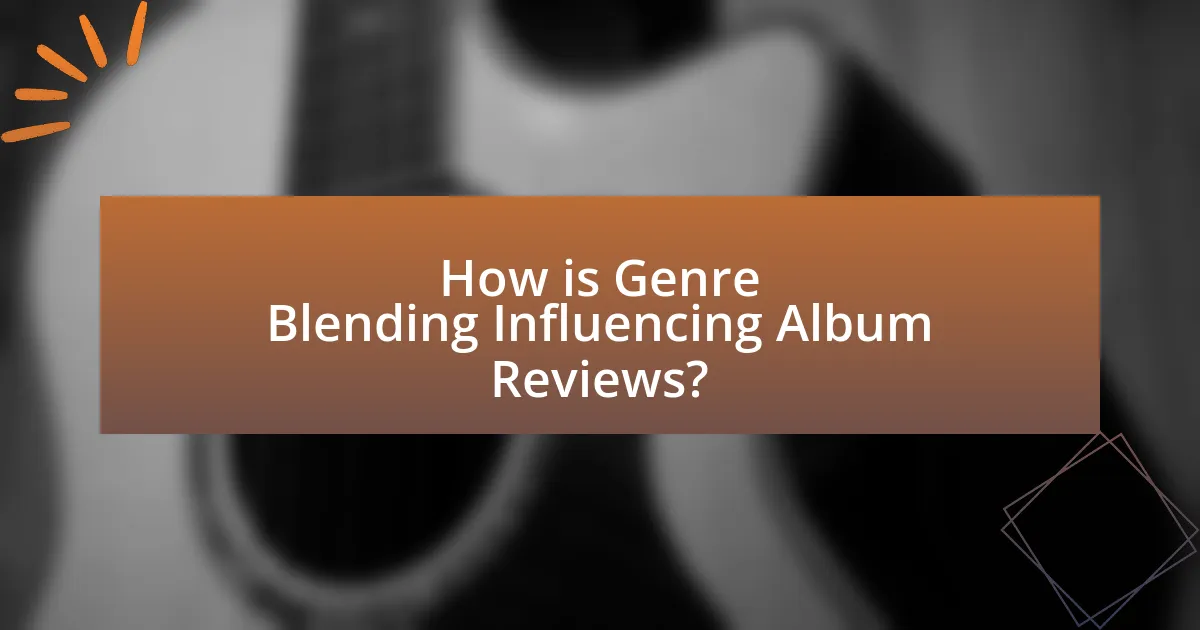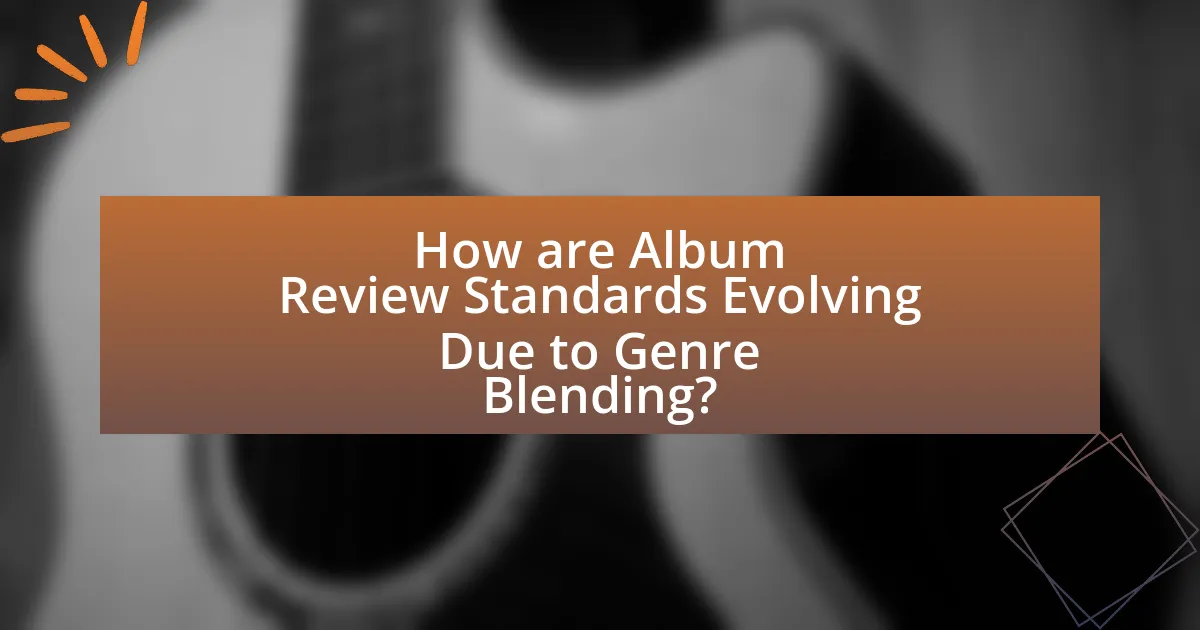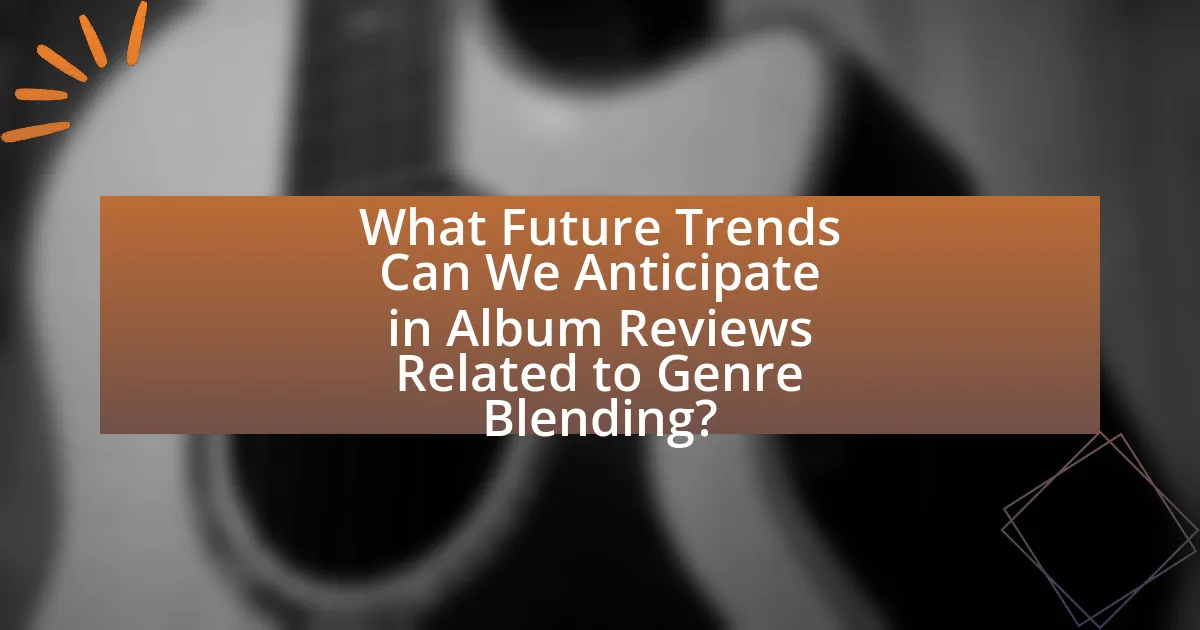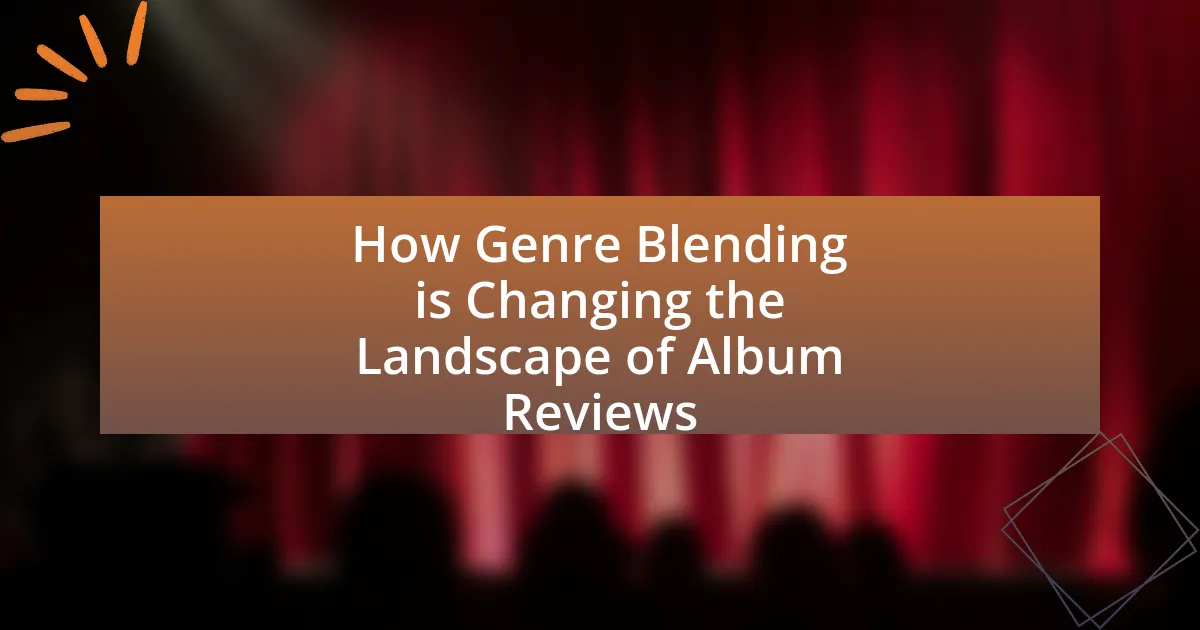Genre blending is significantly transforming the landscape of album reviews by expanding the criteria used by critics to evaluate music. As artists increasingly merge elements from various genres, reviewers are prompted to adopt a more nuanced approach that considers diverse musical techniques, themes, and cultural contexts. This article explores the characteristics of genre blending, its impact on traditional music categories, and the challenges critics face in assessing blended albums. It also discusses how technology and audience expectations shape the evaluation process, highlighting emerging trends in listener preferences and the evolving role of music critics in this dynamic environment.

How is Genre Blending Influencing Album Reviews?
Genre blending is influencing album reviews by expanding the criteria through which critics assess music, leading to more nuanced evaluations. As artists increasingly combine elements from various genres, reviewers are prompted to consider a wider range of musical techniques, themes, and cultural contexts. This shift encourages critics to move beyond traditional genre classifications, allowing for a more holistic understanding of an album’s artistic intent and impact. For instance, albums that blend hip-hop with rock or jazz often receive praise for their innovation and creativity, reflecting a growing appreciation for cross-genre experimentation in contemporary music. This trend is supported by the rise of platforms like Pitchfork and Rolling Stone, which highlight genre-defying works, thereby shaping public perception and critical discourse around music.
What are the key characteristics of genre blending in music?
Genre blending in music is characterized by the fusion of elements from different musical genres to create a unique sound. This blending often results in innovative compositions that defy traditional genre boundaries, allowing artists to explore diverse influences and appeal to a broader audience. Key characteristics include the incorporation of varied instrumentation, cross-genre lyrical themes, and diverse rhythmic structures. For example, the collaboration between hip-hop and country in songs like “Old Town Road” by Lil Nas X illustrates how genre blending can lead to commercial success and critical acclaim, demonstrating its impact on the music industry.
How does genre blending redefine traditional music categories?
Genre blending redefines traditional music categories by merging distinct musical styles, creating hybrid genres that challenge established classifications. This fusion allows artists to explore diverse influences, resulting in innovative sounds that do not fit neatly into conventional genres. For instance, the rise of genres like country-rap and electronic rock illustrates how artists can draw from multiple influences, leading to a more fluid understanding of music categorization. As a result, music critics and listeners are increasingly recognizing these blended genres, prompting a reevaluation of traditional music categories and expanding the framework through which music is analyzed and appreciated.
What examples illustrate successful genre blending in recent albums?
Successful genre blending in recent albums is exemplified by Lil Nas X’s “Montero,” which combines elements of country, pop, and hip-hop, showcasing a seamless integration of diverse musical styles. Another notable example is Billie Eilish’s “Happier Than Ever,” where she merges pop, rock, and jazz influences, creating a unique sound that defies traditional genre boundaries. Additionally, the album “Scaled and Icy” by Twenty One Pilots blends alternative rock with pop and electronic music, illustrating the versatility and appeal of genre fusion in contemporary music. These albums demonstrate how artists are redefining genres, leading to innovative sounds that resonate with a broader audience.
Why is genre blending becoming more prevalent in the music industry?
Genre blending is becoming more prevalent in the music industry due to the increasing accessibility of diverse musical influences and the rise of digital platforms. Artists can now easily experiment with different styles, leading to innovative sounds that attract wider audiences. For instance, the popularity of streaming services allows listeners to discover and share a variety of genres, fostering a culture of cross-genre collaboration. Additionally, data from the Recording Industry Association of America indicates that genre-blending tracks, such as those combining hip-hop and pop, have seen significant commercial success, reflecting changing consumer preferences.
What role do artists play in the rise of genre blending?
Artists are pivotal in the rise of genre blending as they actively experiment with and combine different musical styles, creating innovative sounds that challenge traditional genre boundaries. This experimentation is evident in the works of artists like Billie Eilish, who merges pop with elements of electronic and hip-hop, or Lil Nas X, who blends country with rap, showcasing how artists can redefine genres. The increasing accessibility of music production tools and platforms allows artists to collaborate across genres more easily, further promoting genre blending. This trend is supported by data from the Recording Industry Association of America, which indicates that genre-blending tracks often achieve higher streaming numbers, reflecting audience demand for diverse musical experiences.
How has technology facilitated genre blending in music production?
Technology has facilitated genre blending in music production by providing advanced tools and software that enable artists to easily mix and manipulate different musical styles. Digital audio workstations (DAWs) like Ableton Live and Logic Pro allow for seamless integration of various instruments and sounds from diverse genres, making it simpler for producers to experiment and create hybrid tracks. Additionally, the rise of sampling technology and plugins has expanded the sonic palette available to musicians, encouraging innovative combinations of elements from genres such as hip-hop, electronic, rock, and jazz. This accessibility and versatility in production tools have led to a significant increase in genre-blending music, as evidenced by the popularity of crossover hits and collaborations that defy traditional genre boundaries.
What challenges do critics face when reviewing genre-blended albums?
Critics face significant challenges when reviewing genre-blended albums due to the complexity of categorizing music that defies traditional genre boundaries. The blending of multiple genres can create a unique sound that may not fit neatly into established categories, making it difficult for critics to apply conventional frameworks for evaluation. For instance, an album that combines elements of hip-hop, jazz, and electronic music may confuse critics who rely on genre-specific criteria to assess artistic merit. Additionally, the subjective nature of genre interpretation can lead to varied opinions among critics, complicating consensus on the album’s quality. This challenge is underscored by the increasing prevalence of genre-blending in contemporary music, as seen in the works of artists like Billie Eilish and Lil Nas X, who incorporate diverse influences into their sound, further blurring the lines of genre classification.
How does genre blending complicate the evaluation of musical quality?
Genre blending complicates the evaluation of musical quality by creating a diverse range of stylistic elements that challenge traditional assessment criteria. When artists combine genres, they often defy established norms, making it difficult for critics and listeners to apply conventional standards of quality, such as technical proficiency or adherence to genre-specific conventions. For instance, a song that merges hip-hop with classical music may be evaluated differently based on the listener’s familiarity with either genre, leading to subjective interpretations of its quality. This complexity is supported by research indicating that genre-blending music often receives polarized reviews, as critics struggle to categorize and assess the innovative elements present in such works.
What biases might reviewers have towards genre-blended music?
Reviewers may exhibit biases towards genre-blended music by favoring traditional genres over innovative combinations. This preference can stem from a lack of familiarity with the blended styles, leading to a perception that genre-blended music lacks authenticity or coherence. For instance, a study published in the Journal of Popular Music Studies indicates that reviewers often rely on established genre conventions to evaluate music, which can result in underappreciation of genre-blending as a legitimate artistic expression. Additionally, reviewers may have preconceived notions about what constitutes quality music, which can skew their evaluations of genre-blended works, often dismissing them as experimental or less serious.

How are Album Review Standards Evolving Due to Genre Blending?
Album review standards are evolving to accommodate the complexities of genre blending by emphasizing versatility and innovation over strict adherence to traditional genre classifications. As artists increasingly fuse elements from diverse musical styles, critics are adapting their evaluation criteria to assess creativity, emotional impact, and the seamless integration of different genres. This shift is evident in the rise of reviews that focus on the overall listening experience rather than labeling music within rigid categories, reflecting a broader cultural acceptance of hybrid sounds. For instance, the Grammy Awards have recognized genre-blending works, indicating a shift in industry standards that influences how critics approach album reviews.
What new criteria are being used in album reviews for genre-blended music?
Album reviews for genre-blended music are increasingly using criteria such as innovation in sound, lyrical depth, and the seamless integration of diverse musical elements. These criteria assess how effectively an artist combines different genres to create a unique listening experience. For instance, reviewers now focus on the originality of the fusion, evaluating whether the blend enhances the overall artistic expression or feels forced. Additionally, the emotional resonance and thematic coherence of the lyrics are scrutinized to determine how well they complement the varied musical styles. This shift reflects a broader trend in music criticism that values creativity and complexity in an era where genre boundaries are increasingly blurred.
How do reviewers assess the effectiveness of genre blending in an album?
Reviewers assess the effectiveness of genre blending in an album by analyzing how well the different musical styles integrate to create a cohesive sound. They evaluate the seamlessness of transitions between genres, the originality of the blend, and the emotional impact on the listener. For instance, an album that successfully merges rock and hip-hop may be praised for its innovative approach and the way it enhances the overall narrative of the music. Critics often reference specific tracks that exemplify successful genre fusion, noting how the combination enriches the listening experience and broadens the album’s appeal.
What impact does genre blending have on the overall narrative of an album review?
Genre blending significantly enhances the overall narrative of an album review by introducing complexity and depth to the musical analysis. This complexity allows reviewers to explore the interplay between different musical styles, which can reveal the artist’s versatility and innovation. For instance, when an album incorporates elements from rock, hip-hop, and electronic music, the reviewer can discuss how these genres interact to create a unique sound, thereby enriching the narrative. Additionally, genre blending often reflects cultural shifts and influences, providing context that can deepen the listener’s understanding of the album’s themes and messages. This multifaceted approach not only engages the audience but also encourages a broader appreciation of the music, as seen in reviews of albums like “Awaken, My Love!” by Childish Gambino, which blends funk, soul, and R&B, prompting discussions about its cultural significance and artistic intent.
How are audiences responding to genre-blended album reviews?
Audiences are responding positively to genre-blended album reviews, often appreciating the innovative combinations of styles. This positive reception is evidenced by increased engagement on social media platforms, where listeners share their excitement about the unique soundscapes created by blending genres. Additionally, music streaming services report higher play counts for albums that receive favorable reviews highlighting their genre-blending qualities, indicating a growing interest in diverse musical experiences.
What trends are emerging in listener preferences for genre-blended music?
Listener preferences for genre-blended music are increasingly favoring eclectic combinations that merge elements from diverse musical styles. This trend is evidenced by the rising popularity of artists who successfully integrate genres such as hip-hop with rock, country with pop, and electronic with jazz, reflecting a broader acceptance of musical experimentation. According to a 2022 report by the International Federation of the Phonographic Industry, 70% of listeners expressed enjoyment for music that blends multiple genres, indicating a significant shift in consumer tastes towards more innovative and hybrid sounds.
How do audience expectations shape the way genre-blended albums are reviewed?
Audience expectations significantly influence the review process of genre-blended albums by setting benchmarks for creativity and coherence. Reviewers often assess how well an album meets the anticipated fusion of styles, which can lead to heightened scrutiny if the blending appears forced or inconsistent. For instance, when an artist known for a specific genre experiments with another, audiences expect a seamless integration; failure to deliver this can result in negative reviews. Research indicates that genre-blending can create a divide in listener expectations, as seen in the mixed reviews of albums like “Awaken, My Love!” by Childish Gambino, where some critics praised its innovative sound while others criticized its departure from traditional hip-hop elements. Thus, audience expectations serve as a critical lens through which genre-blended albums are evaluated, impacting both critical reception and commercial success.

What Future Trends Can We Anticipate in Album Reviews Related to Genre Blending?
Future trends in album reviews related to genre blending will increasingly focus on the intersectionality of musical styles, emphasizing the unique combinations that artists create. As genre boundaries continue to dissolve, reviewers will likely adopt a more nuanced approach, analyzing how these blends reflect cultural shifts and listener preferences. For instance, the rise of hybrid genres like trap-pop and country-rap showcases the demand for diverse sounds, prompting critics to explore the implications of these fusions on mainstream music. Additionally, the use of data analytics in music consumption will inform reviews, allowing critics to assess audience engagement and trends in real-time, thereby enhancing the relevance and accuracy of their evaluations.
How might the role of music critics change with the rise of genre blending?
The role of music critics may evolve to focus more on contextual analysis and genre fluidity due to the rise of genre blending. As artists increasingly combine elements from various genres, critics will need to assess music not just within traditional genre boundaries but also in terms of cultural and emotional resonance. This shift requires critics to develop a deeper understanding of diverse musical influences and their implications, as seen in the success of artists like Lil Nas X, who blends country and hip-hop, challenging conventional categorizations. Consequently, music critics will likely prioritize interdisciplinary knowledge and adaptability in their reviews to accurately reflect the complexities of contemporary music.
What skills will critics need to effectively review genre-blended albums?
Critics will need a deep understanding of multiple musical genres to effectively review genre-blended albums. This skill allows critics to identify and appreciate the nuances and influences from various styles, which is essential for a comprehensive analysis. Additionally, critics should possess strong analytical skills to dissect the interplay between genres and assess how they contribute to the overall artistic vision of the album. Familiarity with contemporary music trends and historical context is also crucial, as it enables critics to contextualize the genre-blending within the broader music landscape. These skills ensure that critics can provide informed, insightful reviews that resonate with diverse audiences.
How could social media influence the perception of genre-blended music reviews?
Social media significantly influences the perception of genre-blended music reviews by amplifying diverse opinions and facilitating immediate feedback. Platforms like Twitter and Instagram allow users to share their thoughts on genre-blended music, creating a dynamic dialogue that can shape public perception. For instance, a review that receives widespread shares or likes can enhance the credibility of the reviewer and the music being discussed, while negative feedback can quickly diminish interest. Additionally, algorithms on these platforms often prioritize content that generates engagement, meaning that popular reviews may overshadow more nuanced critiques, thus skewing the overall perception of genre-blended music. This phenomenon is supported by research indicating that social media interactions can alter consumer attitudes and behaviors, as seen in studies by the Pew Research Center, which highlight the role of social media in shaping cultural trends.
What practical tips can artists and reviewers consider regarding genre blending?
Artists and reviewers should prioritize understanding the core elements of each genre they wish to blend, as this knowledge facilitates a more authentic and innovative fusion. By analyzing the defining characteristics of genres, such as instrumentation, lyrical themes, and production techniques, artists can create a cohesive sound that resonates with audiences. Reviewers, on the other hand, should approach genre-blended works with an open mind, recognizing the unique contributions of each genre to the overall piece. This approach allows for a more nuanced critique that appreciates the complexity of the music. For instance, the successful blending of hip-hop and jazz in albums like “To Pimp a Butterfly” by Kendrick Lamar showcases how understanding genre elements can lead to groundbreaking artistry.
How can artists effectively communicate their genre-blended vision to reviewers?
Artists can effectively communicate their genre-blended vision to reviewers by clearly articulating their influences and the intent behind their music. This involves providing detailed descriptions of the genres they blend, explaining how these elements interact to create a unique sound, and sharing personal narratives that connect to their artistic choices. For instance, artists can reference specific musical techniques or lyrical themes that exemplify their genre fusion, which helps reviewers understand the complexity of their work. Additionally, artists can utilize press releases, interviews, and social media to convey their vision, ensuring that reviewers have access to comprehensive context about their music. This approach not only clarifies the artist’s intent but also enhances the reviewer’s ability to accurately interpret and critique the album, as evidenced by the increasing number of reviews that acknowledge the importance of context in genre-blended music.
What best practices should reviewers adopt when evaluating genre-blended albums?
Reviewers should adopt a contextual approach when evaluating genre-blended albums, focusing on the interplay of different musical styles and their impact on the overall sound. This involves analyzing how the blending of genres enhances or detracts from the artistic expression, considering both the technical execution and emotional resonance of the work. For instance, a review should highlight specific elements such as instrumentation, lyrical themes, and production techniques that reflect the fusion of genres. By referencing established genre conventions and comparing them to the album’s unique elements, reviewers can provide a more nuanced critique. This method is supported by the increasing prevalence of genre-blending in contemporary music, as evidenced by the success of artists like Billie Eilish and Lil Nas X, who seamlessly integrate multiple genres into their work, thus reshaping listener expectations and critical standards.
